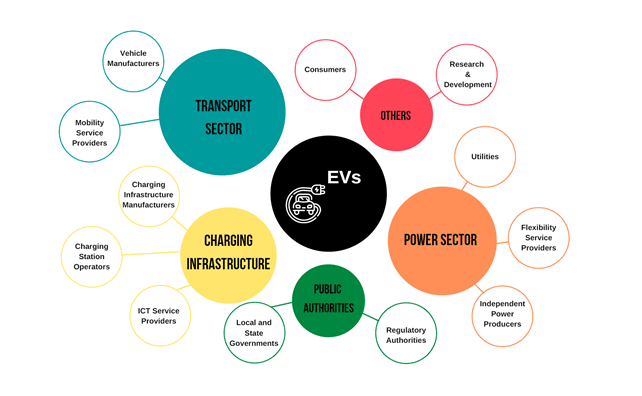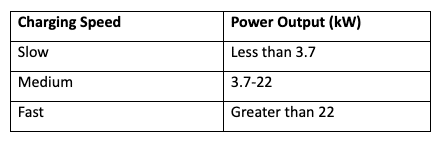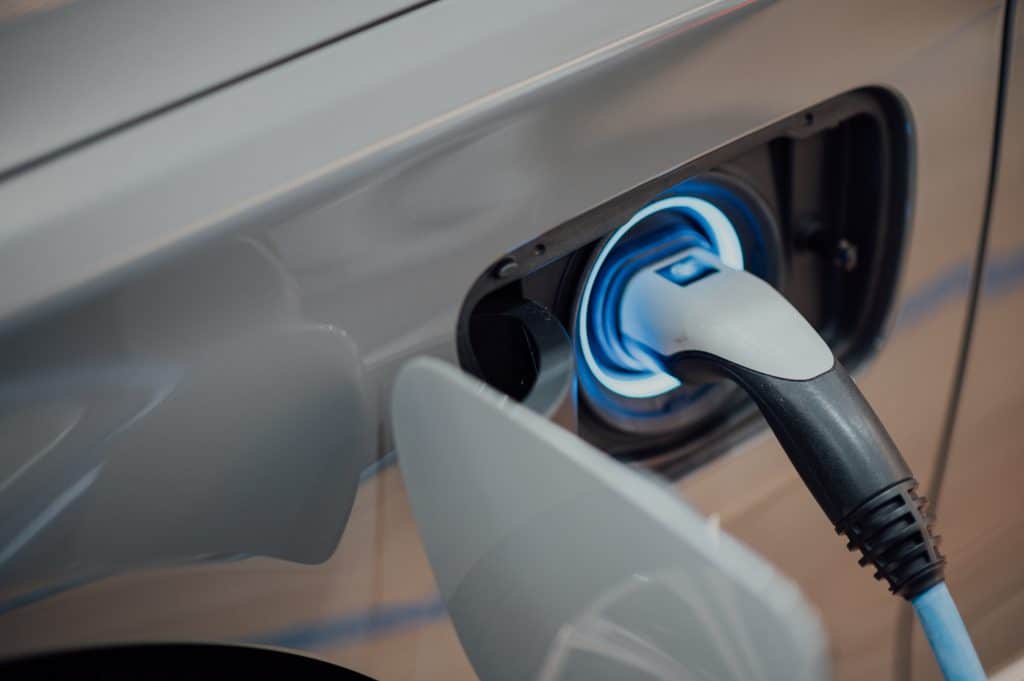Electric Vehicle Charging
As Electric Vehicles infiltrate everyday life everywhere, questions arise on how they should be integrated into different power systems. This article aims to answer some of the most frequently asked questions and to give an energy-centered perspective on this emerging phenomenon.
Electric Vehicles: A Mobility Revolution
The global Electric Vehicle (EV) fleet is poised to increase exponentially in what has been dubbed the electric mobility revolution. The latest edition of the Global EV Outlook report, states that the global EV fleet totalled 7.2 million in 2019 with EVs accounting for 1 % of the global vehicle stock and 2.6 % of global car sales.
Multiple scenarios predict a growing EV fleet, for example, a multi-government policy forum called The Electric Vehicles Initiative (EVI) indicates that EV penetration will increase rapidly in the coming years and the global EV fleet will reach 30% of total new vehicles sold, excluding two-wheelers, by 2030.
The push for EVs is driven by the global climate agenda established under the Paris Agreement to reduce carbon emissions to limit global warming. Importantly, not only would a switch from combustion-engine vehicles to EVs lead to lower emissions (under the condition that the electricity mix is sufficiently decarbonised), EVs also create a lot less local air pollution. In addition, the deployment of EVs is also driven by national agendas to reduce oil demand and as such dependence on oil imports, as well as the encouragement of a local EV manufacturing industry for job creation.

The success of the EV revolution hinges on the timely deployment of effective EV charging infrastructure. However, at the same time, EV adoption is the main driver for the business case of EV charging infrastructure. Policy and regulation, informed by a thorough understanding of the EV charging ecosystem, can offer solutions to this chicken-and-egg problem.
In this introductory article, we present different electric vehicle types and charging infrastructure options. Furthermore, we briefly cover the potential challenges and opportunities presented by large-scale EV deployment on power systems. This topic will be discussed more in depth in the FSR online course on Electric Vehicles: a power sector perspective.
What are Electric Vehicles?
EVs are broadly described by either chassis type or engine type.
The classification by chassis includes two-wheelers, three-wheelers, four-wheelers, trucks, buses and mobile machinery¹.
The following are various engine types :
- Battery electric vehicle (BEV) – These derive all power from battery packs and thus have no internal combustion engine, fuel cell, or fuel tank. BEVs use a rechargeable traction battery pack to store the electrical energy that powers the electric motor. Examples of BEVs include the Nissan Leaf and Tesla Model S.
- Fuel cell electric vehicle (FCEV) – Like BEVs, FCEVs use electricity to power an electric motor and also have components such as electric motors, power controllers or inverters. The major difference between BEVs and FCEVs is the energy source. FCEVs convert the chemical energy of a fuel (often hydrogen) into electricity while BEVs directly use electricity stored in a battery. Examples include the Hyundai Tucson FCEV and Toyota Mirai.
- Hybrid EV (HEV) – HEVs combine a conventional internal combustion engine system with an electric propulsion system and do not plug into an electrical outlet to recharge the battery. Typical technologies used by HEVs include regenerative braking, electric motor drive and automatic start-stop. Plug-in Hybrid EV (PHEVs) afford the user a choice of fuels as they are powered by an alternative fuel or a conventional fuel, such as gasoline (petrol), and a battery, which is recharged by plugging into a charging station. Examples include the Toyota Prius and Chevy Volt.
What is an EV charging infrastructure?
There are various elements to be considered in describing an EV charging infrastructure. These include but are not limited to the charging technology, standardization and ownership. In what follows, we briefly introduce each dimension.
Charging technology
We split this section into three parts: the charging process, the charging speed and the power flow directionality. What you can see is that there are much more degrees of freedom in charging an EV than a combustion-engine car. In this sense, the cost of charging an EV can differ depending on the charging process, speed and power flow directionality.
Charging process
Three alternatives can be differentiated with regards to the process of charging an EV:
- Plug-in charging: This is the most conventional way to charge an EV by means of plugging the EV to an electricity source for recharging. For heavy-duty vehicles such as electric buses and trucks, charging by means of a pantograph delivers a high conductive transfer of energy in a very short time from the charging infrastructure.
- Battery swapping: This approach is currently less conventional. In battery swapping, a discharged battery from the EV is swapped with a charged battery. While battery swapping essentially depends on EV battery compatibility, its suitability may also depend on the different consumer requirements. For example, commercial use EVs and shared mobility may employ battery swapping to minimize the time constraint that arises from slow EV charging.
- Wireless charging: is done by employing resonant magnetic induction to transfer energy between a pad on the ground and another pad under the floor of the EV. Wireless charging may either be static, in which EVs are charged while they are stationary such as in car parks, garages, or at traffic signals; or dynamic, in which EVs are charged while they are in motion. Dynamic wireless charging has the potential to reduce the required battery capacity and ease the EV user’s range anxiety².
Charging Speed
The charging speed, measured as the power output of the EV charger in kW, determines the time it takes for an EV to reach full charge. Typically, the charging speed of an electric vehicle charging facility is categorized into three modes– fast, medium and slow (See Table 1). In terms of the order of magnitude of time, slow charging means obtaining a full charge in a few hours, medium charging in less than an hour and fast charging in minutes.

Power flow directionality
Power flow directionality is described as either unidirectional or bidirectional. Unidirectional chargers only allow power flow from the charger to the EV. Bidirectional chargers allow both power flow to and from the EV and thus enable an EV to provide a wider range of vehicle-to-everything (V2X) services.
Standardization
Consumers will require access to charging services from region to region. This would depend on the interoperability of EV charging infrastructure and payment methods. Interoperability can be determined through prescribing an existing international charging standard in a typical top-down approach. In this case, policymakers specify a range of charging standards to be employed by charging service providers.
Alternatively, manufacturers can utilise their own charger standards. In this bottom-up approach, a market leader would eventually emerge. Lastly, interoperability of charging infrastructure between charging stations, distribution networks and EVs is also necessary for unlocking the flexibility potential of EVs.
Ownership
When making the decision to purchase an EV, the consumer must be assured of readily accessible and conveniently located charging stations. Firstly, EVs can be charged through privately accessible charging spots located at the EV users’ private home, housing complex or place of business.
Secondly, EVs can be charged through publicly accessible charging stations, these may be located in public parking lots, malls or even along highways. Charging point ownership and location also influences the consumer’s preferred charging speed. For example, fast charging would be better suited for public charging stations in order to ensure they serve as many EVs as possible.
All over the globe, there are ongoing discussions about which actor would be best to own and operate publicly accessible charging infrastructure. The most common approach is to allow commercial third parties or the regulated Distribution System Operator (DSO) to manage the charging infrastructure. For example, the European Union Clean Energy Package mandates the Member States to promote market-based schemes for the ownership of EV charging infrastructure. Member States may still allow DSOs ownership of EV charging infrastructure but only under certain conditions.
What is the impact of electric vehicles on the power system?
EVs can be viewed as a mobile, power-dense and unpredictable additional load as well as a flexible and reliable Vehicle-to-everything (V2X) resource.
From EV as a load perspective, uncoordinated EV charging can lead to an increase in peak demand at local and system level. The former creates the need to reinforce networks to avoid local service interruptions. The latter can mean that more generation capacity needs to be installed to guarantee that all loads can be served at all times, thereby possibly increasing the cost of electricity supply. However, various solutions are emerging as alternatives to help defer these investments. These alternative solutions include sending price signals to EV users to shift load from peak hours to off-peak hours and utilize the distribution grid when it is uncongested by redesigning retail tariffs.
Furthermore, EV owners can actively participate in providing various V2X services and generate revenue by either injecting electricity by discharging the EV battery, extracting electricity by charging the EV battery or abstaining from consumption by ceasing to charge the EV.
Notes:
¹ According to Council of the European Union and European Parliament, (2007) Mobile Machinery means “any self-propelled vehicle which is designed and constructed specifically to perform work which, because of its construction characteristics, is not suitable for carrying passengers or for transporting goods. Machinery mounted on a motor vehicle chassis shall not be considered as mobile machinery.”
² Range anxiety is defined as the concern of the vehicle operator that the EV is running out of energy.
If you still have questions or doubt about the topic, do not hesitate to contact one of our academic experts:
Relevant links
- Charging up India’s Electric Vehicles Policy brief: Addresses the major challenges to achieving rapid growth in EV uptake required to reach India’s policy targets.
- Charging up India’s Electric Vehicles Technical Report: Full report on the major challenges to achieving growth in EV uptake required to reach India’s policy targets.
- The FSR Global Electric Vehicles online course is designed for professionals who wish to address the power sector challenges posed by the ever-growing number of EVs on a global scale.
- EV revolution: a power sector view on coupling with mobility: Online debate discussing in-depth the EV revolution that will greatly impact two key sectors: power and mobility.
- FSR Talks on India’s EV Charging Report: Online talk Join to explore the toolbox consisting of solution choices and recommendations to tackle deployment of electric vehicle charging infrastructure in India.






